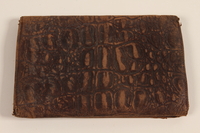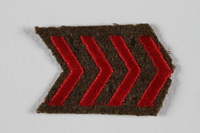Overview
- Brief Narrative
- Military arm patch worn by Leo Englard when he served as a soldier in the Jewish Brigade Group during World War II. This patch is modeled on the emblem previously adopted by the Jewish Agency during the British Mandate in Palestine that became the national emblem following the creation of the state of Israel in 1948. The British Army established the Jewish Brigade Group in September 1944. It included more than 5,000 Jewish volunteers living in Palestine and was the only independent, national Jewish unit to serve in WWII. The unit served in combat during the final battles for the liberation of Italy. The British dissolved the Brigade in the summer of 1946. Leo remained in Palestine and married Fanny Dominitz, a German Jewish Holocaust survivor who emigrated to Palestine in 1947. The couple had known each other in Germany and had corresponded throughout the war.
- Date
-
use:
1944 September-1946 July
- Geography
-
issue:
Palestine
- Credit Line
- United States Holocaust Memorial Museum Collection, Gift of Fanny Englard
- Contributor
-
Subject:
Fanny Englard
Subject: Leo Englard
- Biography
-
Fanny Dominitz was born September 9, 1925 in Cologne, Germany, to Jakob Dominitz, a traveling businessman, born on November 26, 1899, and Scheindel Ungar Dominitz, born April 18, 1897, both in Tarnow, Poland. She had four brothers, all born in Cologne: Leo Markus on November 6, 1926, a second brother in 1928, Isidor Izi on July 29, 1929, and a fourth, birth date unknown. She also had sisters, one by the name of Tzipora. Hitler’s appointment as Chancellor in 1933 led to increasingly severe restrictions on Jews. The government sanctioned anti-Jewish boycotts and enacted anti-Jewish legislation. In 1935, the Nuremberg Laws defined Jews by race and mandated the total separation of Aryans and non-Aryans. Fanny’s parents decided in 1936 that her father should leave Cologne for Katowice, Poland, because Jewish men were at a high risk of arrest and deportation. By January 1, 1938, German Jews were prohibited from operating businesses and trades, and from offering goods and services. On October 28, 1938, the Germans expelled nearly 20,000 Polish Jews from Germany in the Polenaktion, including Fanny’s father, mother, brothers, sisters and grandma; all were sent to the Bentschen internment camp.
In 1940, Fanny left Cologne and joined the Youth Hachschara in Rissen, Schleswig-Holstein, near Altona, to gain agricultural skills and obtain a visa to emigrate to Palestine. She entered a Jewish girl’s orphanage in Hamburg and trained as a housekeeper from 1940 to November 1941, when she received orders to report to the Gestapo for deportation to a labor camp in Minsk as part of the 4th Hamburg-Altona transport. On December 4, the deportees met at the Talmud Tora School and learned that Rabbi Dr. Joseph Carlebach, who visited with Fanny at the Hachschara, was to head this transport. On December 6, the group was loaded into police vans for transport to the Hannoversche goods depot and informed that they were going to the Jungfernhof concentration camp in Riga, Latvia. The 3-4 day trip terminated at Skirotava station 3 miles from Riga on Dec 10, 1941. The prisoners were forced to march in the snow to Jungfernhof, a former agricultural estate with no sanitary facilities, running water, or toilets. Women and men were separated and housed in barracks with no protection from the weather or the cold. Rabbi Carlebach was the chief Rabbi at Jungfernhof and a mediator for the Jews. Fanny became friends with his daughter, Noemi, and worked at the factory Meteor.
The Germans closed Jungfernhof in March 1942 and Fanny, along with 200 other girls, was deported to the Riga ghetto. In November 1943, the few surviving members of the 4th transport were transferred to Kaiserwald concentration camp near Riga. Fanny deported again on August 9, 1944, to the Stutthof concentration camp in Poland, where she was labeled a political prisoner and given the identification number 60 992. In October 1944, she was transferred to Sophienwald labor camp, a subcamp of Stutthof near Stolp, Poland. With the Russian army closing in on Sophienwald, the camp was evacuated on January 25, 1945 and the prisoners were forced on a 62 mile death march to Lauenberg, Poland. In March 1945, the prisoners were again forced to march to Gydni, Poland; the inmates believed that they were to be put on a ship which the Germans then intended to sink. Instead, they were liberated near Lauenberg by the Soviet Army on March 3, 1945.
After liberation, Fanny tried to find surviving family members. She learned that her mother and 10 year old brother, along with the other family members expelled during Polenaktion, were deported from Bentschen to Belzec, and killed in the gas chambers in 1939. Jakob was deported to the Warsaw ghetto and died from typhus in June 1941. Fanny’s brothers, 15 year old Isa and 12 year old Leo, were part of a transport leaving Cologne for the Minsk ghetto. They were killed in a mass shooting in Balgortchina, near Belarus, on July 28, 1942. Only one brother survived; he had managed to get to England. Fanny emigrated to Palestine in May 1947 and married Leo Englard. Fanny has talked about her Holocaust experiences to many organizations over the years. She found that, in order to set up a new life, it is necessary to have peace, not hatred. And that to believe as a Jew in the hope of 'Never Again' it is necessary to be vigilant: "We have not survived to witness the same fate once again."
Leo Englard was a soldier in the Jewish Brigade Group during World War II. He emigrated to Palestine before 1939 from Germany where he probably was born, somewhere near Cologne. He may have been a member of a non-combatant Palestine regiment prior to the formation of the Jewish Brigade Group. Palestine was governed by a British mandate sanctioned by the United Nations. The British Army established the Jewish Brigade in September 1944. It included more than 5,000 Jewish volunteers from Palestine and was the only independent, national Jewish military unit to serve in World War II. They served in combat in the final battles for the liberation of Italy under the command of Brigadier Ernest Benjamin. The British disbanded the unit in the summer o f 1946. Leo married Fanny Dominitz, a German Jewish refugee and concentration camp survivor, who emigrated to Palestine in 1947. The couple had known each other in Germany and had corresponded throughout the war.
Physical Details
- Classification
-
Military Insignia
- Category
-
Badges
- Object Type
-
Color patches (military patches) (aat)
- Physical Description
- Square cloth military patch with a yellow Star of David embroidered in gold thread upon 3 equal vertical stripes of blue, white, blue. There is yellow stitching around the edges.
- Dimensions
- overall: Height: 2.120 inches (5.385 cm) | Width: 2.120 inches (5.385 cm)
- Materials
- overall : cloth, thread
Rights & Restrictions
- Conditions on Access
- No restrictions on access
- Conditions on Use
- No restrictions on use
Keywords & Subjects
- Topical Term
- Jewish soldiers--Palestine. Jews, German--Palestine.
- Corporate Name
- Great Britain. Army. Jewish Brigade
Administrative Notes
- Legal Status
- Permanent Collection
- Provenance
- The Jewish Brigade arm patch was donated to the United States Holocaust Memorial Museum in 2007 by Fanny Englard, the widow of Leo Englard.
- Record last modified:
- 2023-09-15 10:20:05
- This page:
- https://collections.ushmm.org/search/catalog/irn35769
Download & Licensing
In-Person Research
- By Appointment
- Request 21 Days in Advance of Visit
- Plan a Research Visit
- Request to See This Object
Contact Us
Also in Fanny and Leo Englard collection
The collection consists of a metal shard, military patches, and a wallet, correspondence, documents, and photographs relating to the experiences of Fanny Dominitz in Germany and several concentration camps during the Holocaust and of Leo Englard in Palestine and the Jewish Brigade Group during World War II.
Date: 1938-1947

Embossed brown leather bi-fold wallet used by a soldier in the Jewish Brigade, British Army
Object
Wallet that belonged to Leo Englard when he served as a soldier in the Jewish Brigade Group during World War II. The British Army established the group in September 1944. It included more than 5000 Jewish volunteers living in Palestine and was the only independent, national Jewish unit to serve in WWII. The unit served in combat during the final battles for the liberation of Italy. The British dissolved the Brigade in the summer of 1946. Leo remained in Palestine and married Fanny Dominitz, a German Jewish Holocaust survivor who emigrated to Palestine in 1947. The couple had known each other in Germany and had corresponded throughout the war.

Bent metal shard saved by a soldier in the Jewish Brigade, British Army
Object
Metal piece that belonged to Leo Englard, who served as a soldier in the Jewish Brigade Group during World War II. The British Army established the group in September 1944. It included more than 5000 Jewish volunteers living in Palestine and was the only independent, national Jewish unit to serve in WWII. The unit served in combat during the final battles for the liberation of Italy. The British dissolved the Brigade in the summer of 1946. Leo remained in Palestine and married Fanny Dominitz, a German Jewish Holocaust survivor who emigrated to Palestine in 1947. The couple had known each other in Germany and had corresponded throughout the war.

Jewish Brigade Group embroidered shoulder title patch worn by a Brigade soldier
Object
Shoulder title patch worn by Leo Englard when he served as a soldier in the Jewish Brigade Group during World War II. The British Army established the group in September 1944. It included more than 5000 Jewish volunteers living in Palestine and was the only independent, national Jewish unit to serve in WWII. The unit served in combat during the final battles for the liberation of Italy. The British dissolved the Brigade in the summer of 1946. Leo remained in Palestine and married Fanny Dominitz, a German Jewish Holocaust survivor who emigrated to Palestine in 1947. The couple had known each other in Germany and had corresponded throughout the war.

Jewish Brigade Group arm patch with 4 red chevrons worn by a soldier in the Brigade
Object
Chevron patch worn by Leo Englard when he served as a soldier in the Jewish Brigade Group during World War II. The British Army established the group in September 1944. It included more than 5,000 Jewish volunteers living in Palestine and was the only independent, national Jewish unit to serve in WWII. The unit served in combat during the final battles for the liberation of Italy. The British dissolved the Brigade in the summer of 1946. Leo remained in Palestine and married Fanny Dominitz, a German Jewish Holocaust survivor who emigrated to Palestine in 1947. The couple had known each other in Germany and had corresponded throughout the war.

Jewish Brigade Group uniform patch with 1 red stripe worn by a Brigade soldier
Object
Uniform patch worn by Leo Englard when he served as a soldier in the Jewish Brigade Group during World War II. The British Army established the group in September 1944. It included more than 5,000 Jewish volunteers living in Palestine and was the only independent, national Jewish unit to serve in WWII. The unit erved in combat during the final battles for the liberation of Italy. The British dissolved the Brigade in the summer of 1946. Leo remained in Palestine and married Fanny Dominitz, a German Jewish Holocaust survivor who emigrated to Palestine in 1947. The couple had known each other in Germany and had corresponded throughout the war.
Fanny and Leo Englard papers
Document
Documents, correspondence and photographs regarding Fanny Dominitz, who survived several concentration camps, and her husband Leo Englard, who served in the Jewish Brigade Group during World War II.



